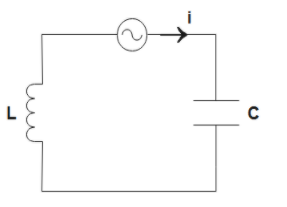
A capacitor of capacitance of \[2\mu F\] is connected in the tank circuit of an oscillator oscillating with a frequency of \[1kHz\]. If current flowing in the circuit is \[2mA\], the voltage across the capacitor will be-
(A).\[0.16V\]
(B).\[0.32V\]
(C).\[79.5V\]
(D).\[159V\]
Answer
555k+ views
Hint: When a capacitor or inductor is connected in an AC circuit, then reactance is calculated. It is the resistance offered by elements like capacitors and inductors to the flow of current through them. The voltage drop across them is related to the value of their reactance.
Formulas Used:
\[{{X}_{c}}=\dfrac{1}{\omega C}\]
\[\omega =2\pi f\]
\[V=I\times {{X}_{c}}\]
Complete answer:

When there are inductors or capacitors connected in a circuit, they tend to oppose the flow of current through them. This property is called reactance (\[R\]).
For a capacitor, the value of \[R\]will be-
\[{{X}_{c}}=\dfrac{1}{\omega C}\] - (1)
Here,
\[{{X}_{c}}\] is the reactance due to capacitor
\[\omega \,\] is the angular velocity
\[C\] is the capacitance
We know that,
\[\omega =2\pi f\] - (2)
Here, \[f\] is the frequency
Substituting eq (2) in eq (1), we get,
\[{{X}_{c}}=\dfrac{1}{2\pi fC}\]
\[\begin{align}
& {{X}_{c}}=\dfrac{1}{2\pi \times {{10}^{3}}\times 2\times {{10}^{-6}}} \\
& \\
\end{align}\]
\[\Rightarrow {{X}_{c}}=\dfrac{{{10}^{3}}}{4\pi }\] - (3)
The formula for voltage across element of reactance is-
\[V=I\times {{X}_{c}}\]
Here,\[V\] is voltage across the capacitor
\[I\] is the current in the circuit.
Substituting values in the above eq, we get,
\[\begin{align}
& V=2\times {{10}^{-3}}\dfrac{{{10}^{3}}}{4\pi } \\
& \therefore V=0.16V \\
\end{align}\]
The voltage across the capacitor is \[0.16V\].
Hence, the correct option is (A).
Additional Information:
AC circuits or alternating current circuits are those circuits in which the value of current and voltage is not constant. The value of current oscillates about a mean value whereas in DC circuits or direct current circuits, the value of current is constant. LC circuits are AC circuits in which a capacitor (\[C\]) and an inductor (\[L\]) are connected together. It is also called a tank circuit
Note:
Capacitors and inductors, both show reactance. When resistors are connected in combination with capacitors or inductors or both, the reactance is called impedance. It is calculated as \[Z=\sqrt{{{X}_{c}}^{2}+{{X}_{i}}^{2}+{{R}^{2}}}\] . Here, \[{{X}_{i}}\] is reactance of inductors, \[R\] is resistance.
Formulas Used:
\[{{X}_{c}}=\dfrac{1}{\omega C}\]
\[\omega =2\pi f\]
\[V=I\times {{X}_{c}}\]
Complete answer:

When there are inductors or capacitors connected in a circuit, they tend to oppose the flow of current through them. This property is called reactance (\[R\]).
For a capacitor, the value of \[R\]will be-
\[{{X}_{c}}=\dfrac{1}{\omega C}\] - (1)
Here,
\[{{X}_{c}}\] is the reactance due to capacitor
\[\omega \,\] is the angular velocity
\[C\] is the capacitance
We know that,
\[\omega =2\pi f\] - (2)
Here, \[f\] is the frequency
Substituting eq (2) in eq (1), we get,
\[{{X}_{c}}=\dfrac{1}{2\pi fC}\]
\[\begin{align}
& {{X}_{c}}=\dfrac{1}{2\pi \times {{10}^{3}}\times 2\times {{10}^{-6}}} \\
& \\
\end{align}\]
\[\Rightarrow {{X}_{c}}=\dfrac{{{10}^{3}}}{4\pi }\] - (3)
The formula for voltage across element of reactance is-
\[V=I\times {{X}_{c}}\]
Here,\[V\] is voltage across the capacitor
\[I\] is the current in the circuit.
Substituting values in the above eq, we get,
\[\begin{align}
& V=2\times {{10}^{-3}}\dfrac{{{10}^{3}}}{4\pi } \\
& \therefore V=0.16V \\
\end{align}\]
The voltage across the capacitor is \[0.16V\].
Hence, the correct option is (A).
Additional Information:
AC circuits or alternating current circuits are those circuits in which the value of current and voltage is not constant. The value of current oscillates about a mean value whereas in DC circuits or direct current circuits, the value of current is constant. LC circuits are AC circuits in which a capacitor (\[C\]) and an inductor (\[L\]) are connected together. It is also called a tank circuit
Note:
Capacitors and inductors, both show reactance. When resistors are connected in combination with capacitors or inductors or both, the reactance is called impedance. It is calculated as \[Z=\sqrt{{{X}_{c}}^{2}+{{X}_{i}}^{2}+{{R}^{2}}}\] . Here, \[{{X}_{i}}\] is reactance of inductors, \[R\] is resistance.
Recently Updated Pages
Master Class 12 Economics: Engaging Questions & Answers for Success

Master Class 12 Maths: Engaging Questions & Answers for Success

Master Class 12 Biology: Engaging Questions & Answers for Success

Master Class 12 Physics: Engaging Questions & Answers for Success

Basicity of sulphurous acid and sulphuric acid are

Master Class 12 Business Studies: Engaging Questions & Answers for Success

Trending doubts
How much time does it take to bleed after eating p class 12 biology CBSE

Explain sex determination in humans with line diag class 12 biology CBSE

Differentiate between homogeneous and heterogeneous class 12 chemistry CBSE

When was the first election held in India a 194748 class 12 sst CBSE

Explain sex determination in humans with the help of class 12 biology CBSE

December 10th of 1948 is an important day in the history class 12 sst CBSE




